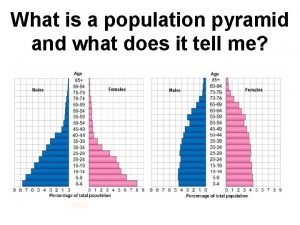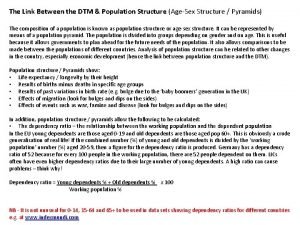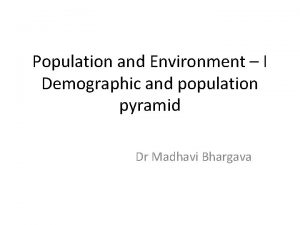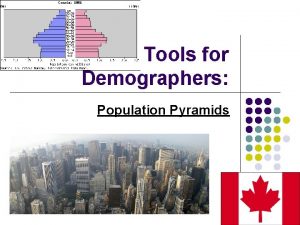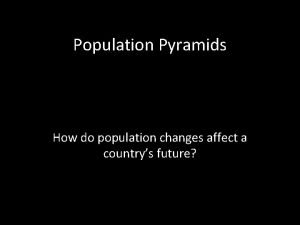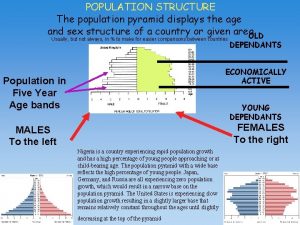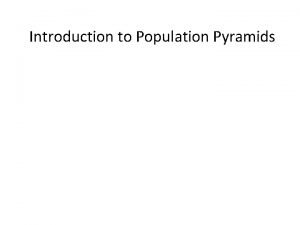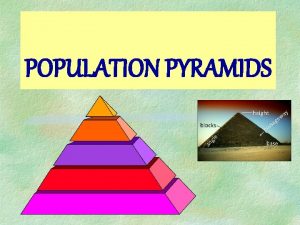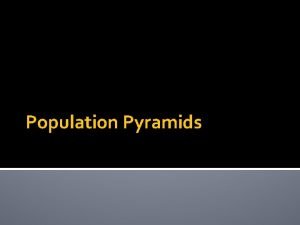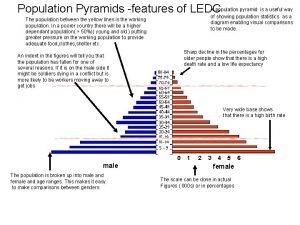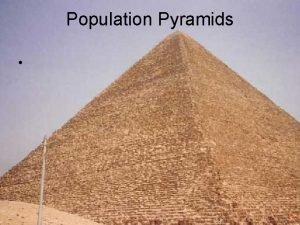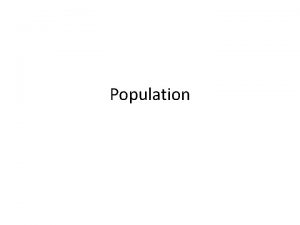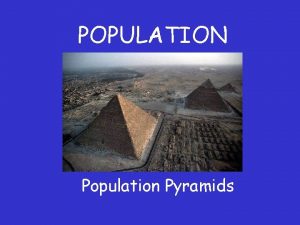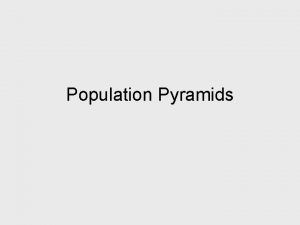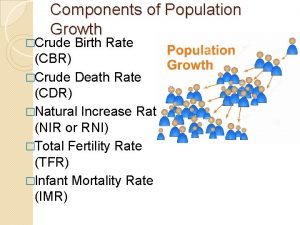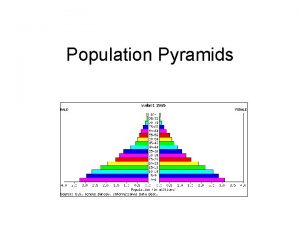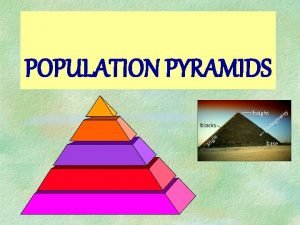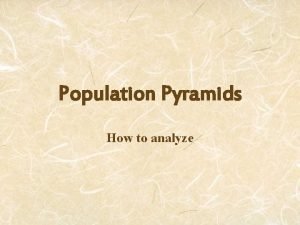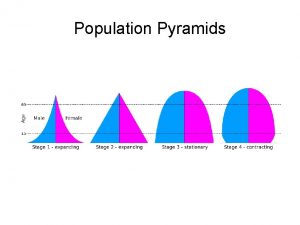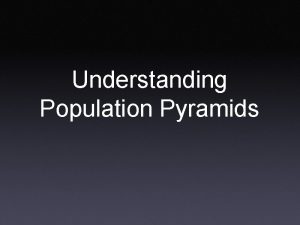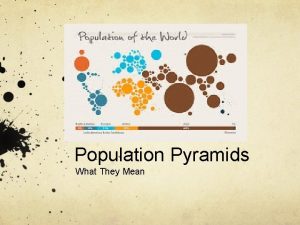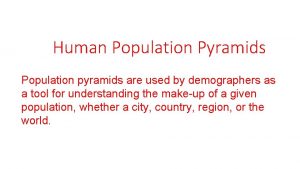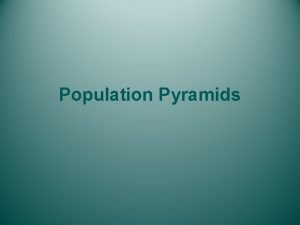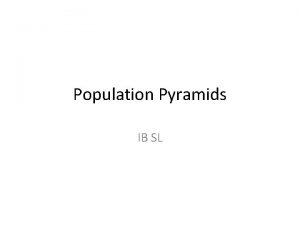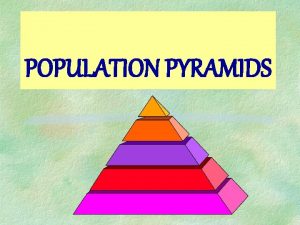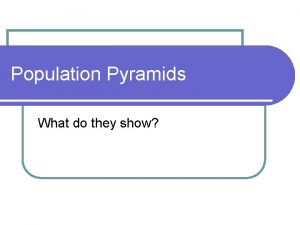POPULATION PYRAMIDS What is a population pyramid It



























- Slides: 27

POPULATION PYRAMIDS

What is a population pyramid? § It is a diagram that gives information about the proportion of males and females in each age group. § Also shows: - proportion of young people (0 -14 ) - proportion of working people (15 – 59) - proportion of elderly people (60+) Each age-group designation is called a COHORT

What is a population pyramid? Vertical Axis - Age Groups Elderly dependents Working population Young dependents Horizontal Axis – Percentage / number

How to read a population pyramid? § Read the title e. g. country or city or racial group § Comment on general shape of the pyramid § Note the proportion of people in various age groups (cohorts) § Note the sex ratio § Interpret the data


Types of Population Pyramid 1. Triangular-shaped 2. Beehive-shaped Pyramid 3. Rectangular-shaped Pyramid Shape of pyramids is controlled by Births (but mostly CBR!) l deaths, & l migrations. l

Triangular-shaped Pyramid (Broad-based Pyramid)

Broad-based Pyramid Title: India, 2000 Shape: Broad Base - high birth rates Narrow Top - small elderly pop - high death rate Proportion: - Large proportion of young - high young dependency ratio Sex Ratio: Balance pyramid - Balance sex ratio

STOP § Where is India on the Demographic Transition Model?

Indonesia 2000 Malaysia 2000


Beehive-shaped Pyramid

Beehive-shaped Pyramid Title: Singapore, 2000 Shape: Rocket-shaped / Narrow Base – Low Birth Rates, Slow pop growth Proportion: Large proportion of working population, 15 -59 yr old - large group of economically active pop Sex Ratio: Balanced pyramid

Hong Kong 2000 Taiwan 2000

STOP § Where are Beehive shaped pyramids on the Demographic Transition Model?

Rectangular-shaped Pyramid

Rectangular Pyramid Title: Netherlands, 2000 Shape: Rectangular-shaped - Zero Pop Growth Narrow Base - Low Birth Rates - Life-expectancy is high e. g. 80+ - Low death rates Proportion: Bars of equal length - Balance Proportion Sex Ratio: Balance pyramid - Balance Sex Ratio

UK 2000 Netherlands 2000

STOP § Where are Rectangular Based Pyramids on the Demographic Transition Model?

Population Structure and Composition § Population pyramids…show age and gender groups. How do MDC’s and LDC’s differ? l 1. ) Sex Ratio: # of males per 100 females. In general slightly more males born, but women outlive men • Eur and NA 95 males: 100 females • World wide 102 males: 100 females

Pop Structure and Composition – cont’d. § 2. ) Age Distribution l Dependency Ratio: # of people too old or young to work, compared to # of people in productive yrs. • % of pop under 15 = % over 65 divided by % in between 15 -65 multiplied by 100 • Tells you how many dependents for every 100 workers • Stage 2 countries: ratio is 1: 1 (1 worker for every dependent) Dependents are young • Stage 4 countries ratio is 2: 1 (2 workers for every dependent) Dependents are young and old

Age Distribution – cont’d l l l Graying of the pop in MDCs – more than ¼ of all govn’t expenditures in US, Canada, Japan, and W. Eur goes to Social Security, health care, and other programs for the elderly Baby Boomer Cohort in US (born 19461964)…what does this mean for you? Generation X = 1965 -1980

What do you see? Why?


Population Pyramids in Transition

Importance of Population Pyramids § Policy Planning ~ future housing estates ~ future schools ~ future jobs § Comparison with other countries ~ developed (US) vs developing (India)

 Types of population pyramids
Types of population pyramids Idb population pyramids
Idb population pyramids Population pyramids
Population pyramids Dtm pyramid
Dtm pyramid Irregularities in population pyramids
Irregularities in population pyramids Beehive shaped pyramid
Beehive shaped pyramid Population pyramids definition
Population pyramids definition How to read population pyramids
How to read population pyramids Population pyramids
Population pyramids Demographic transition model population pyramids
Demographic transition model population pyramids Population structure
Population structure Beehive shaped pyramid
Beehive shaped pyramid Analyzing population pyramids
Analyzing population pyramids Population pyramids
Population pyramids Why do geographers use population pyramids
Why do geographers use population pyramids Selected population pyramids in the united states
Selected population pyramids in the united states Features of population pyramid
Features of population pyramid Total population of europe
Total population of europe Newly industrialized country population pyramid
Newly industrialized country population pyramid Newly industrialized population pyramid
Newly industrialized population pyramid Unalaska ak population pyramid
Unalaska ak population pyramid Convex population pyramid
Convex population pyramid Beehive population pyramid
Beehive population pyramid Italy population pyramid
Italy population pyramid Military base population pyramid
Military base population pyramid Population pyramid russia
Population pyramid russia Population pyramid vocabulary
Population pyramid vocabulary Beehive shaped population pyramid
Beehive shaped population pyramid


